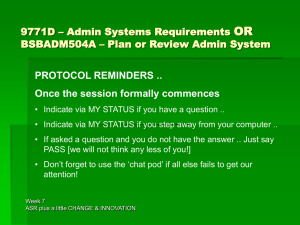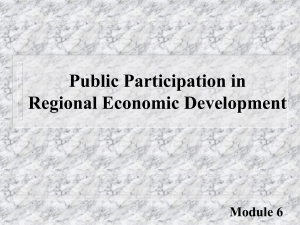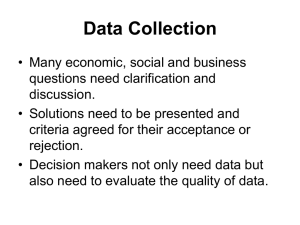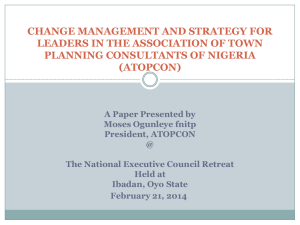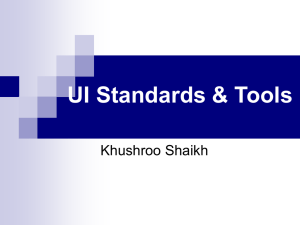treatment of water-module-iii - Engineering E books For Free
advertisement
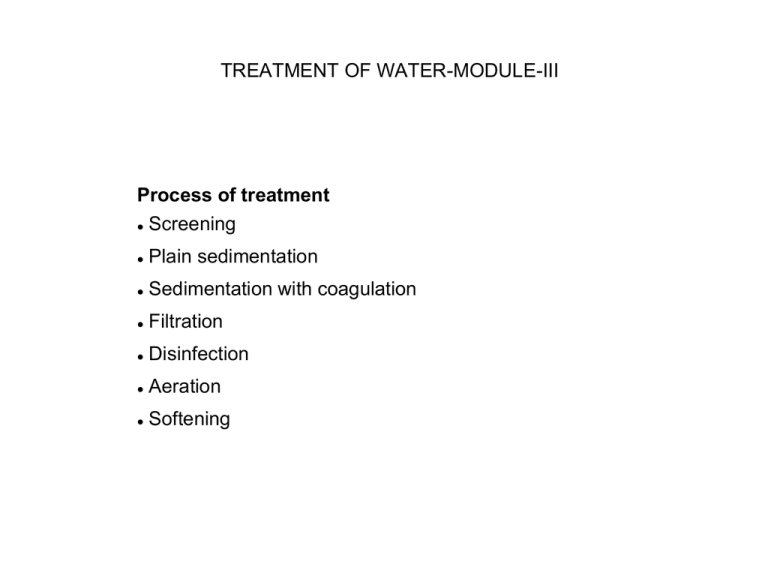
TREATMENT OF WATER-MODULE-III
Process of treatment
Screening
Plain sedimentation
Sedimentation with coagulation
Filtration
Disinfection
Aeration
Softening
TREATMENT OF WATER - CONTD
Miscellaneous methods such as→ Fluoridation, Re carbonation,
Liming, Desalination
Screening
Coarse screen
Fine
screens
↓
Vertical rods/pipes, dia.2-10cm
↓
Small wires of dia.
less than 1cm
Placed 45°-60° inclined
perforated metals
Limiting the velocity, 0.8-1m/sec
Material collected U/S
should be removed
TREATMENT OF WATER - CONTD
TREATMENT OF WATER - CONTD
Theory of sedimentation
The settlement of the particles depends on the following
Velocity of flow
Viscosity of the water
The size and shape
Sp. Gravity
Stokes’s law
TREATMENT OF WATER - CONTD
Sedimentation-Principles→
Most of the particles are higher sp. gravity than water, 1.02-2.65
Particles of sp. gravity greater than 1.2, may settle down in still
water
A chamber/ a tank is provided to reduce the turbulence/ entry
velocity, called sedimentation tank
The average time for which the water detained in the
sedimentation tank is called the detention period
TREATMENT OF WATER - CONTD
Vs = (g/18)*(G-1)*d²/v for, d=0.1mm → Used for spherical particles
Vs→ Settling velocity in m/sec.
G → sp.gravity
d → diameter of the particle in metres
v → kinematic viscosity of water in m²/sec.
Vs =418(G-1)*d² [(3*T+70)/100], for d=0.1mm→ stream line settling
T → Temp. in °C
Vs→mm/ sec.
d → diameter in mm
Vs =1.8gd*√ (g-1) for d>0.1mm →Turbulent settling
Note: Grit particles are normally in between, 0.1mm and 1mm and settling
velocity is given by
Vs = 418(G-1)*d [(3T+70)/100]
TREATMENT OF WATER - CONTD
Type of sedimentation tank
Sedimentation tank
↓
Horizontal flow type← → Vertical flow type
↓
Rectangular with horizontal flow
Circular with radial flow
Concepts in plain sedimentation tank (Type-I Settling)
Consider a fluid particle entering in the bottom of the tank, which
moves upwards with a velocity of flow, say v₀ and settling velocity
of vs. Then the particle does not move up if the settling velocity is
more than the liquid rise velocity.
TREATMENT OF WATER - CONTD
TREATMENT OF WATER - CONTD
TREATMENT OF WATER - CONTD
V₀ →Discharge/Surface area → volume/time
Surface area
(Surface area*depth)/time
Surface area
→ depth
time
That is liquid velocity
Note: This is also called the overflow rate/ overflow velocity/
surface overflow rate/surface loading
As long as the settling velocity is greater than the overflow
rate, particles settle down and can be removed.
TREATMENT OF WATER - CONTD
Assumptions made in the horizontal settling tank
Particles and their velocity vectors are evenly distributed across
the tank cross section and is a function of the inlet zone
The liquid moves as an ideal slug, down the length of the tank
Any particle hitting the tank bottom can be removed
Let us consider the water containing the uniformly distributed
particles enters the tank cross section, with a uniform velocity, v
as given by
v → Q/B*H
B → width of the tank
H → height of the tank
Q →discharge entering the basin
TREATMENT OF WATER - CONTD
TREATMENT OF WATER - CONTD
From the figure, it can be concluded that
The particle entering at the top of the tank with a velocity less than the
settling velocity is settle down as defined by the line AC →v < Vs
Some particle that enter below the line AC, with velocity greater than its
settling velocity may also settle down provided the condition that, Vs =
(h/H)v₀ is satisfied.
Also from the figure,
V/Vs → L/H
→Vs = v * (H/L)
→Vs = Q * H
→
B*H * L
That is the overflow rate itself.
Q
As
→ v₀
TREATMENT OF WATER - CONTD
Detention period
The theoretical time taken by a particle entering in to the tank to leave
the tank or the time detained in the tank and is given by →
Volume of the tank
Rate of flow
BLH
Q
Problem: Design a sedimentation tank for a purification plant of
max. daily demand of 12M.litres. Assume 6 hr. detention period
and 20 cm/min. flow velocity.
TREATMENT OF WATER - CONTD
Solution:
Q = [12 * 10⁶ * 6]/[ 24 * 1000] → 3000m³
v = 0.20m/min
L = velocity * detention period → 0.20 * 6 * 60 → 72m
Cross sectional area → Q/L → 3000/72 → 41.7m²
Assume a depth of 4m
B → 41.7/4 → 10.42, say 10.5m
Assume 0.50m freeboard
Overall depth → 4.50m
Size of the tank → 72mx10.50mx4.50m
TREATMENT OF WATER - CONTD
Problem: 2 M. liters of water per day passing through a
sedimentation tank which is 6m wide, 15m long and having a
water depth of 3m. Find
Detention period
Ave. flow velocity
Amount per day of suspended solid if the contamination is
60ppm and sp. gravity is 2. Assume 70% removal in the tank
Overflow rate
TREATMENT OF WATER - CONTD
Solution:
Q = 2x10⁶lit.
→ 2000m³/day. → 83.33m³/hr
Detention period
→ V/Q → [6x15x3]/83.33 → 3.24hr
Ave. flow velocity → Q/BH →83.33/3x6
→ 4.62m/hr
→ 7.72cm/min.
Quantity of water → 2→10⁶lit/day
Concentration of particle → 60ppm
Quantity of material → [2x10⁶x60]/10⁶ → 120lit/day
Materials removed → @70% → 120x0.70 →84lit. →0.084m³
Overflow rate → Q/LB
→ 83.33x10³lit/hr
15mx6m
→ 926lit/hr/m²
Sedimentation with coagulation (Type II settling)
The particles of comparatively larger size may settle down in plain
sedimentation tank of ordinary detention period. But these particles and
even smaller sized particles can easily be settle by increasing their size by
changing them in to flocculated particles. Certain chemicals, called
coagulants when added to the water which on through mixing forms
gelatinous precipitate called floc. These floc as moves downward attracts
smaller colloidal particles and become bigger and bigger in size and settle
easily
ρf = ρw + kd^ -0.7
Where,
ρf → density of floc
ρw → density of water
k → coefficient depending on the charecteristics of water and chemicals
d → diameter of the particles
TREATMENT OF WATER - CONTD
Chemicals used as coagulant
Alum
Copperas
Chlorinated copperas
Sodium aluminates
Alum → Aluminum sulphate Al₂ (SO₄)₃18H₂O
When added to water reacts with bicarbonate alkalinities and
forms gelatinous precipitate of aluminum hydroxide
Reaction involves CaSO₄ → imparts hardness
Reaction includes evolution of CO₂ → corrosiveness
Optimum dosage is determined by laboratory test
TREATMENT OF WATER - CONTD
Depending on turbidity, 5-85mg/lit
Normal dosage is 17mg/lit
Effective in a pH range of 6 -8.5 and made alkaline by adding lime etc.
Copperas → Ferrous sulphate (FeSO₄7H₂O)
Generally added to raw water after mixing with lime
Forms ferrous hydroxide
When oxidizes, form ferric hydroxide
Forms floc
Note: Used when raw water, not coloured
Cheaper than alum
Function pH above 8.50
Dosage is same as Alum
TREATMENT OF WATER - CONTD
Chlorinated copperas →chlorine when added to ferrous sulphate
The resultant reaction is a combination of ferric sulphate and
ferric chloride and is known as chlorinated copperas
The reaction with raw water forms ferric hydroxide → floc formation
Note:
Effective coagulant for almost all pH range
Effective for coloured water
TREATMENT OF WATER - CONTD
Sodium aluminates → (Na₂Al₂O₄)
Reacts with salts of calcium and magnesium present in
water
Produces calcium and magnesium aluminates
Note: Approximately 1.50 times costlier than Alum
Reduced hardness → used as boiler feed water
TREATMENT OF WATER - CONTD
Comparison of Aluminium and Iron salts as coagulant
Iron forms heavy floc and more effective than Alum
Iron salts - being good oxidizing agent can remove hydrogen sulphide
→ taste and odour
Used over a vide range of pH
Iron salts produce staining and promote growth of iron bacteria
in distribution system
Imparts corrosiveness than Alum
Handing and storage requires skill and care
TREATMENT OF WATER - CONTD
Constituents of a coagulation sedimentation tank
A feeding device
A mixing device/ mixing basine
Flocculation tank/ Flocculator
Settling/ sedimentation tank
Type of feeding devices →
Dry feeding
Wet feeding
TREATMENT OF WATER - CONTD
TREATMENT OF WATER - CONTD
TREATMENT OF WATER - CONTD
Choice of selection depends on the following
Charecteristics of coagulant and convenient with which it can be applied
Non uniform chemicals cannot be used as dry
Alum
→ wet and dry
Copperas
→ not dry feeding, but wet feeding
Activated carbon → only dry feeding
Cost of the coagulant and the size of the plant
Purchase of the coagulant in cheapest form-Then plant is equipped with
to use in the same form based on the initial cost of device and cost of
coagulant
If the plant is small, the feeding device should govern (small → dry feeding)
Large plant
The amount of coagulant used
Very small dose → solution form
→ watch and ward for mixing etc.
TREATMENT OF WATER - CONTD
Mixing device
Around the end baffle
Over and under the baffle
Problem:
Design the water depth for a mixing basin having around the end
baffle in order to meet 48MLD of water. The tank divided in to two
similar compartments by providing a longitudinal partition wall
and each half may have a clear width of 8m. Assume suitable
values of detention period and flow velocity through the basin.
The clear distance between baffles may be kept as equal to
minimum permissible. Mention the number of channels in the
tank and also the overall inside length of the tank.
TREATMENT OF WATER - CONTD
TREATMENT OF WATER - CONTD
TREATMENT OF WATER - CONTD
Solution:
Volume of water → 48x10⁶ /(24x1000) → 2000m³/hr
Assume a detention period of 30minutes (20-50 minutes)
Volume of water/30 minutes → 2000/2 → 1000m³
Assume the flow velocity of 0.30m/sec (0.15-0.45m/sec)
Length of flow → velocity x time
→ 0.30x30x60 →540m
Cross sectional area of the channel
→ 1000/540
The distance b/w baffle
→ assume as 45cm (min)
Then the depth of water
→ 1.85/0.45 → 4.12m
→ 1.85m²
TREATMENT OF WATER - CONTD
Say → 4.2m
Clear distance b/w the wall and baffle → 1.50 times the distance
b/w baffles
1.5x45 → 70cm
Effective length → 8 - 2x half opening→8 - 2x0.50x70 → 7.30m
Number of channels required → 540/7.3 → 74 Nos
That is 74/2 → 37channelsin each half of the tank
Clear length of channel → 37x0.45+ [(37-1) x (7.5/100)] → 19.35m
TREATMENT OF WATER - CONTD
Flocculator
The best floc will form when the mixture of water and coagulant are
violently agitated followed by relatively slow and gentle stirring to permit
build up and agglomeration of the floc particles. The water from mixing
device is taken to a tank fitted with paddles operated by electric motors,
called flocculator, where it is given a slow stirring motion.
Types of Flocculator → flash type mixer and Deflector plate mixer
Flash mixer → Speed of paddles @ 2-3 rpm
Detention period → 30minutes (20-60minutes)
Clear distance between paddles/walls → 15-30cm
The rolling motion provided by the paddles keeps the floc in
suspension
TREATMENT OF WATER - CONTD
TREATMENT OF WATER - CONTD
TREATMENT OF WATER - CONTD
Sedimentation tank
↓
Plain sedimentation tank ↔ combined coagulation cum sedimentation tank
Plain sedimentation tank (When coagulant is not used) →
Low detention period→ 2 - 4 hr
Higher overflow rate → 1000 – 1250lit/hr/m²
TREATMENT OF WATER - CONTD
TREATMENT OF WATER - CONTD
TREATMENT OF WATER - CONTD
Combined coagulation cum sedimentation tank →
Detention period – Floc chamber
→ 15-40 minutes
Detention period – Settling chamber → 2 – 4 hr
Depth of flocculator
Depth of settling tank → 3 – 6 m
Cleaning @6 months
→ Half of the depth of settling tank
Problem: Design a coagulation sedimentation tank with continues
flow for a population of 60,000 people with a daily percapita water
demad of 120 litre. Make suitable assumption if needed.
TREATMENT OF WATER - CONTD
TREATMENT OF WATER - CONTD
Solution:
Population
→ 60,000
Quantity of water → 60,000x120 lit/day
→ 7.20x10⁶lit/day
Assume the daily max.as1.80 times of daily ave.demand →
Quantity of water → 7.20x10⁶lit/day x 1.80 → 12.96 x 10⁶ lit/day
Assuming a detention period of 4hr, water to be treated →
12.96 x 10⁶ x (4/24) → 2.16x10⁶lit.
→ 2.16 x 10³ m³
Hence, capacity of the tank
→ 2.16 x 10³ m³
Assume an overflow rate of 1000lit/hr/m²
Q/BL →1000 → or BL → Q/ overflow rate →
→
12.96x10⁶lit/hr
24x1000
→540m²
TREATMENT OF WATER - CONTD
Assume a width of 12m
Then, the length of the tank →540/12 → 25m
The depth of the tank →Capacity of tank/plan area → 2.16x10³m³
→ 4m
540m²
Assuming, 50cm freeboard, overall depth → 4.50m
Hence size of the tank → 45mx12mx4.5m
Design of flocculator
Assume the depth of the chamber → Half of the tank →0.50 x 4.50 →2.25m
Assume, 20minutes detention period (flocculator)
Capacity of the chamber
→
12.96x10⁶x20
24x60
→
The plan area required
180m³
→ 180/2.25
→ 80m²
The length of the flocculator → 80/12 → 6.67m, say → 6.70m
TREATMENT OF WATER - CONTD
Filrtation → Filtration is the process of passing water through a layer of a
granular material.
Aim
To remove vey fine suspended impurities, from the effluent from
the sedimentation tank.
To remove pathogenic bacteria
TREATMENT OF WATER - CONTD
RESULT
Odour free water
Tasty water
Colourless water
Free from pathogenic organism in hygienic point of view
Theory of Filtration
Mechanical straining
Sedimentation and flocculation
Biological metabolism
Electrolytic action (process)
TREATMENT OF WATER - CONTD
Mechanical straining → according to aperture size → The water gets
filtered by arresting the impurities present as the fluid particles pass
through the granular space between the filter media
Sedimentation and flocculation →Acts as tiny sedimentation tank →
The impurities in the effluent water from coagulation sedimentation tank
is a gelatinous material and will collect within the voids of sand particles
as it passes through the media under gravity or pressure. These voids
with gelatinous material will act as minute flocculation sedimentation
tank attracting and depositing particles smaller than the void space,
improving its performance as a filter again and again.
TREATMENT OF WATER - CONTD
Biological Metabolism →The living organism/bacteria present in sand
particles use the organic matters for their survival and convert them in to
harmless compound. These compounds forms a layer known as dirty
skin and which again absorb and strain the impurities. This process is
known as biological metabolism and the dirty layer which assists and
enhances the process of filtration is called the dirty skin or
schmutzdecker.
Electrolytic action → Normally the sand particles and impurities are
oppositely charged. These attract each other and neutralize them by
changing the character of water. The exhausted particles again charge
by cleaning
.
Classification of filters
Based on rate of filtration
Slow sand filters
Rapid sand filters
↓
Rapid gravity filters ↔
Pressure filters
Based on pressure
Pressure filters
gravity filters
↓
Slow sand filters
↔
Rapid sand filters
TREATMENT OF WATER - CONTD
Slow sand filters
Components →
Enclosure tank
Filter media
Base material
Under drainage system
Inlet and outlet arrangements
Enclosure tank
An open watertight tank
Depth→ 2.50-3.50m
Plan area → 100-2000m²
TREATMENT OF WATER - CONTD
TREATMENT OF WATER - CONTD
Filter Media
A sand layer of 90 to 120 cm height
Normally 4 or 5 layer
Finer particles as top layer
Top 15cm, uniformly graded
Uniformity coefficient
At top
→ 1.8
Mid level
→ 2.50
At bottom
→3
Effective size – D10 → 0.2 to 0.4mm
It should be free from dirt and impurities
It should be hard and durable
It should be uniform in nature and size
It should not lose its weight more than 5%, after being placed in
HCl for 24 hrs.
TREATMENT OF WATER - CONTD
Base material
3 to 4 layers of 15-20 cm thick gravel
Top most layer
3 - 6mm
6 - 12mm
↓
12 - 20mm
20 - 40mm
Bottom
40 - 65mm
Under drainage system
A sloped floor to collect the water in the central width wise drain
Open jointed laterals are placed 3 - 4 m c/c
Central drain collects the water from laterals and delivers to the
outlet chamber.
TREATMENT OF WATER - CONTD
Inlet and outlet arrangements
Inlet is a suitable size (square), chamber
Inlet allow the entering water to distribute uniformly on filter bed
Outlet chamber is also a similar one
In order to maintain constant head, a telescopic(adjustable) pipe
is fitted
Note:
The loss of head is minimum possible → 15-30cm
The maximum → 0.70 -1.20m, above which cleaning is required
The water treated with coagulants should not be permitted to
enter the slow sand filters
The depth of water on the filter bed should not varies much,
normally kept equals to the depth of sand bed
TREATMENT OF WATER - CONTD
The loss of head called filter head is kept approximately equal to
0.70-0.80 times the depth of sand, to put it out of service for
cleaning
Cleaning of slow sand filters are done by scrapping and removing
1.50-3cm, top layer
The pure water comes out only if dirty skin layer is formed
Generally cleaning depends on the impurities presents →1-2 months
Rate of filtration → 100-200lit/hr/m²
Efficient against bacteria removal as high as 98-99%
Remove odour and taste, by removing organic impurities
TREATMENT OF WATER - CONTD
Colour removal →up to 50mg/l
Uses
Uneconomical, due to small rate of filtration and large area
→For small water supply schemes
requirements
Problem:
Design a slow sand filter bed for the following data
Population
→ 50,000
Percapita demand →150lit/person/day
Rate of filtration →180lit/hr/m²
Length of bed twice its width
Assume 1 unit out of 6 as standby
TREATMENT OF WATER - CONTD
Solution:
Quantity of water → 50,000x150x1.8 →13.5x10⁶lit/day →562.50m³/hr
Surface area
→ Q/rate of filtration →562.50x10³lit/hr
180lit/hr/m²
→ 3125m²
Area of each unit
Also,
Hence,
→ 3125/5 → 625m²
L→ 2B
2B² = 625
B → 17.67, Say →18m
L →36m
Hence, provide 6 units of 36mx18m
TREATMENT OF WATER - CONTD
Rapid sand filters
Components of Rapid sand filter
Enclosure tanks
Open rectangular water tight tank,
Depth
→
2.5 to 3.5 m
Filler area
→
10-80 m2
Number of units →
1.22
Q
Where Q
→
plant capacity in MLd
Min
→
2 units
TREATMENT OF WATER - CONTD
TREATMENT OF WATER - CONTD
Filter Media
Sand bed
→ 60-90 cm depth, each layer 15-20 cm
D10
→ 0.35 to 0.55mm
Uniformity coefficient
→1.3-1.7
Finer to coarse towards bottom
Base Material
Gravel bed
Top most layer
→ 60 - 90cm
3 - 6mm
6 - 12mm
↓
12 - 20mm
20 - 40mm
Bottom
40 - 65mm
Note: Carefull grading and packing is important for smooth
function, especially in backwashing
TREATMENT OF WATER - CONTD
Under drainage system
Manifold and lateral system →
Perforated pipe system
Pipe and strainer system
Perforated pipe system
6-13mm dia. holes are made, inclined 30℃with vertical, near bottom
Placed 7.5cm (6mm) and 20cm (13mm)
Sometimes holes are staggered
Sometimes brass bushings are inserted
Placed over 40-50 mm cement concrete block.
TREATMENT OF WATER - CONTD
Pipe and Strainer system
Laterals are attached to manifold
Instead of perforation, strainers are fixed at suitable intervals (15cm, c/c)
Sometimes strainers are fixed on main pipe without laterals
When strainers are used, rate of back washing is as low as 250-300 lit/min/m2
(Low washing) against 700-800lit/min/m² (High washing) for other types
TREATMENT OF WATER - CONTD
Design Considerations
Total cross-sectional area of perforation is about 0.2% of filter
area
The cross-section area of 6mm dia. pipe is 4 times the
perforation in it
The cross-sectional area of 13 mm dia. pipe 2 times the
perforation
The c/s area of manifold should be twice that of laterals
l/d of laterals, >60
Maximum velocity in the manifold is 1.80 to 2.4 m/sec
TREATMENT OF WATER - CONTD
Other appurtenants
Wash water trough
square or v shape
Any material such as iron or CI
1.5 to 2m c/c
Provided with small slope
As large as possible
TREATMENT OF WATER - CONTD
Air compressor unit
Duration of application → 4min or so
Rate
→ 600 – 800 lit/min/m2
Application
→ through lateral or separate pipe
Rate controller
Venturi rate controller → to regulate the flow
Head loss indicator (Piezometer) →A mercury gauge is attached to both the
filter bed and filtered water drain
TREATMENT OF WATER - CONTD
Back washing
Rate
→ 15-90 cm rise/minute, ave. → 45cm
Duration
→ 10-30 minutes
Pressure
→ 40 kN/m2
Frequency
→ 24 - 48 hrs
Problems of sand filters
Air binding and negative head
Formation of mud balls
Cracking of filters
TREATMENT OF WATER - CONTD
Air binding and negative head
Normally there should be a loss of head in filter bed as and when the
water percolates through the voids of sand grain due to friction. This
decrease in pressure is called the loss of head or head loss. The head
loss immediately after commissioning of the filter unit will be as low as
about 10-15 cm. But as the time increases, the deposition of impurities
within the voids of sand particles may increase and correspondingly the
head loss may also increase even up to 2.5 to 3.5 m max. Due to the
increase of friction, a negative head is formed just below the top of layer
of 10-15 cm thick and is called the negative head. The negative head
causes to releases, air bubbles, which stick on sand particles resulting
problems on efficient and proper working of the filter unit. The air
binding may be due to the development of negative head, growth of
algae, rising temperature etc.
TREATMENT OF WATER - CONTD
The various remedial measures are:
Prevent development of negative head, max. → 1..2m
Preventive measures for growth of algae
Necessary measures to control the temperature rise, as and
when the water percolates through the filter media
Allowing the water to supersaturate with air.
TREATMENT OF WATER - CONTD
Formation of mud balls
The mud particles from the atmosphere may attract and
accumulate on the surface of sand grains forming a solid mass.
As the time increases the impurities may deposit more and more
and the size and weight of the solid thus formed called mud balls
may increase. These mud balls sink through the filter media and
finally deposit within the voids of the gravel particles of base
material, resulting clogging. Due to the continuous process, the
entire base material becomes clogged resulting the efficient and
proper functioning of the unit.
TREATMENT OF WATER - CONTD
Remidial measures
Mechanical racking of mud balls and back washing
Backwashing with high pressure at the initial stages
Backwashing with manual breaking
Total replacement
Note: After washing the bed, caustic soda is applied in 10cm on
the bed, left for 12hrs. After 8hrs. of agitation washed until clear
water is obtained
TREATMENT OF WATER - CONTD
Cracking of filters
The top layer of fine sand may generally cause formation of
cracks, and mud particles will be deposited within these cracks.
The cracking of top layer may increase due to the passage of time
and finally affects the working of the filter bed
.
Remedial measures
Removal of the mud deposit from the cracks.
TREATMENT OF WATER - CONTD
Efficiency and Performance
Rate of filtration
→
3000-6000 lit/hr/m2
Removal of bacteria
→
80-90%
Removal of turbidity
→
35-40 mg/l
Turbidity
→
10 unit on cobalt scale
Uses
Most efficient and economic for public water supply
scheme
TREATMENT OF WATER - CONTD
Problem:
Design a rapid sand filter with its components to meet 4 MLD.
Assume the following data
Rate of filtration 5000/lit/hr/m2.
Dia. of perforation 13 mm.
Length =1.5 times the width.
The discharge of a rectangular flat bottom through is given by
1.376bd3/2. Where
b →width, d →depth
TREATMENT OF WATER - CONTD
Water required
→ 4 MLD
Allow for washing
→ 3-4%
→ 3/100x4 = 0.12 MLD
Therefore total
→ 4.12 MLD
========
Assume 30 minutes for washing
Therefore, Q
→ 4.12 = 0.175ML/hr
23.5
Rate of filtration
→ 5000 lit/hr/m2
Area of filter bed
→ 0.175x10⁶lit/hr
5000lit/hr/m²
→ 35m2
TREATMENT OF WATER - CONTD
Assume 2 units
Therefore area of 1 unit
→ 35/2
= 17.5m2
L
→ 1.5B
Bx1.5B
→ 17.5
1.5B²
→ 17.5
B
→ 3.42m
L
→ 3.42x1.5 →5.13m, say → 5.2m
Length
→ 5.2m
Therefore B
17.5/5.2 → 3.36m, say → 3.40m
Provide 2 units of
5.20 mx 3.40m
TREATMENT OF WATER - CONTD
Design of laterals
Total area of perforation
→
0.2% of filter area
→
0.2 x 5.2 x 3.4
100
→
0.0354m2
Assume the c/c distance of laterals as 15cm
No. of laterals
→
5.2/0.15 → 34.67
→
35nos
Total no. of laterals on both sides →
→
35x2
70 nos.
TREATMENT OF WATER - CONTD
Assume ‘n’ is the no. of perforations/each lateral
Area of perforation
→
0.0354m2
0.0354x10⁴
→
n x /4 x 1.3² x70
Therefore n
→
3.76
→
4.nos
The c/s area of laterals
= 2 times the area of perforation in it
2x4x (π/4) x1.3² → 10.61cm²
(π/4) xd²
d
→ 10.61
→3.67cm, say → 3.70cm
Hence provide 70 nos. of 3.7 cm dia laterals on both sides with 4
nos. of 1.3 cm dia of holes, on each.
c/s area of main drain (manifold) →
2 x total area of laterals
→
2 x70 x (π/4)x 3.70²
→
0.15m2.
π/4 d²
→
0.15 x 10⁴
d
→
→
Length of lateral
0.437m
45 cm
========
→
3.4 – 0.45
2
→
l/d
→
1.475m
========
1.4750.037
→ 40.97 < 60
Velocity of flow within the laterals
Assume rate of washing
→ 45cm/min
Wash water discharge
Q
→AxV
→ (5.2 x 3.4) x (0.45/60)
→ 0.1326m3/sec
========
Velocity in the lateral
→ Q/A
→
0.1326m³/sec
70[(/4)(0.037)²]
→ 1.76m/sec
Velocity in main drain
→ Q/A
→ 0.1326
/4 (0.45)2
→ 0.834 m/sec
Max. Value of velocity is 1.8 to 2.4 m/sec, design
is OK
Design of Trough
No. of wash water troughs
Say,
Discharge in each trough
→
5.2/3 → 1.73
→
2 no. of troughs
→
Q/2
→
0.1326/2 = 0.066m3/sec
→
1.376 bd3/2
Assume,
→
25cm
0.066m3/sec
→
1.376(0.25)d3/2
d3/2
→
0.1977
→
0.334m
→
0.35m
Discharge in trough
d
Assuming a free board of 5cm, size of trough
→
20cm x 40cm
TREATMENT OF WATER - CONTD
Pressure filters
Just like small rapid gravity filters, the difference is the filtration is
under pressre
→ 30-70m (300-700kN/m²)
Pressure
Diameter of the tank → 1.50-3.00m
Length of the tank
→ 3.50-8.00m
Rate of filtration
→ 2-5 times that of rapid gravity filter
Rate of filtration
→ 6,000-15,000lit/hr/m²
Efficiency → Less efficient in killing bacteria (80%) and turbidity
removal, than rapid gravity
Uses
→ Not recommended for large water supply schemes
TREATMENT OF WATER - CONTD
TREATMENT OF WATER - CONTD
Advantages
A compact machine, handled easily, automatic units can be
designed
Higher rate of filtration hence, less space and material for the same
volume.
Sedimentation, coagulation tanks can be avoided
More flexible as the rate of filtration can be changed by changing
pressure of raw water.
For small scale supply, proved to be economical
Filtered water is under pressure and need not required further
pumping in most cases.
Disadvantages
The overall capacity of the tank is small
Less efficient in killing bacteria and removing turbidity .
Uneconomical for large supply
TREATMENT OF WATER - CONTD
As the process is in a closed tank proper inspection is difficult
Cleaning and replacement of material is difficult
Working of wash water troughs is not perfect
As the raw water is to be kept under high pressure, high rate of
pumping, and make effluent poorer
Other types of filters
Roughening filters
Diatomaceous filters
TREATMENT OF WATER - CONTD
TREATMENT OF WATER - CONTD
DISINFECTION
Disinfection of water → effluent from filters again contains
pathogenic organism, and it become essential to remove or kill
the same organism before used for drinking
Residual sterilizing effect → There are chances of
contamination of water from the disinfection plant during
transmission etc. and requires some amount of disinfectant in the
distribution line to make the water safe against possible future
contamination
TREATMENT OF WATER - CONTD
Minor methods of disinfection
Boiling
Treatment with excess lime
Treatment with ozone
Treatment with Iodine
Treatment with Ultraviolet
Treatment with potassium permanganate
TREATMENT OF WATER - CONTD
Treatment with excess lime
Lime is used for water softening
4-43mg/lit of excess lime may remove99.3-100% bacteria [pH →9.5]
Requires removal of excess lime by methods like recarbonation
Treatment with ozone → Ozone is an unstable allotropic form of
oxygen, containing three atoms
3O₂ → under high electric voltage →2O₃
↓
↓
Oxygen molecule
Ozone
Then readily breakdown
→
O₃→------------→
O₂ ---------------+------------ O
↓
Ozone
↓
Oxygen
↓
TREATMENT OF WATER - CONTD
Nascent oxygen
Nacent oxygen is a powerful oxidizing agent and removes organic matter and
bacteria from water
Ozone is bubbled through the water in a separate chamber having inlet and
outlet arrangement
2―3mg/lit Ozone → make 0.1mg/lit residual Ozone for a contact period of
10mints.
Detects by orthotolidine test [same yellow colour of 0.1mg/lit →0.15mg/lit
TREATMENT OF WATER - CONTD
Advantages of Ozone treatment
Being unstable, nothing will be there in distribution
Remove colour, taste, and odour
Pleasing and tasty water
Disadvantages
Costlier than chlorination
Possible where electricity is easily and cheaply available
No assurance against future contamination
Ozonizer should be installed in the plant itself [as it cannot be
supplied in cylinder]
Less efficient in killing bacteria than chlorine
TREATMENT OF WATER - CONTD
Bromine and Iodine treatment
8mg/lit for 5mint. Contact period
Available in the form of pills also
Normally used in small supply, private plant, Army troop etc.
Treatment with Ultraviolet
Ultra violet rays → Wave length of about, 1000-4000mµ
Produced by passing electric current through mercury enclosed in
quarts bulb
The bulb is then immersed in water 10cm or below
Advantages
Pure odourfree, colorless water with turbidity of below 15mg/lit
Kills all type of bacteria
Normally used for sterilizations at hospitals
Disadvantages
Very costly
Possible interruption by electricity
TREATMENT OF WATER - CONTD
Treatment with potassium permanganate →
Dosage -----------------1-2mg/lit with a contact period of4-6hrs.
0.05-0.1mg/lit ---------used even in chlorinated water
The treated water is used after 48hrs.
Kills only 98% bacteria
Acts as oxidizing agent to oxidize organic matters
A precipitate on porcelain surface
TREATMENT OF WATER - CONTD
Chlorination →
Chlorine is the best and most ideal disinfectant and widely used all
over the world
The reactions →
Hypochlorous acid (unstable)
pH>5
↑
Cl₂ +H₂O ---------→ HOCl---------- +---------OCl
Hydrogrn ion
hypochlorite ion
←pH < 7
↑
↑
HOCl ------------ ↔-----------H⁺------------ +-----------OCl⁻
pH > 8→
TREATMENT OF WATER - CONTD
Free available chlorine → Hypochlorous acid Hypochlorite ion
and chlorine
Out of the above three, hypochlorous acid is more effective [80
times than hypochlorite ion] disinfectant → As HOCl is unstable it
may dissociate effectively at a pH > 8`
But in between pH 5 and 7 it may exist in solution
Hence the aim is to keep the pH slightly less than 7
TREATMENT OF WATER - CONTD
Other chemical equations are →
Monochloramine → above pH 7.5
↑
NH ₃ + HOCl ---------- → NH₂Cl----- +-----H₂O
Di chromine → pH 5 - 6.5
↑
NH ₂Cl + HOCl --------→ NHCl₂------ +----H₂O
Nitrogen trichloramine → pH below 4.4
↑
NHCl₂ + HOCl --------→ NHCl₃------ +----H₂O
TREATMENT OF WATER - CONTD
Note:
At pH range of slightly less than 7, di chloramines is predominant
Chloramines are less effective, 25 times than free chlorine
Combined chlorine with ammonia in the form of chloramines is called
combined chlorine and is much less effective compared to free
chlorine
Chloramines immediately react with organic impurities [S⁻⁻, Fe⁺⁺,
Mn⁺⁺, NO²⁻ etc.] to form chloride
Then the remaining chlorine reacts with ammonia to form chloramines
The demand of chlorine for the above said reactions are called
chlorine demand and the remaining chlorine is called free chlorine
TREATMENT OF WATER - CONTD
Dosage → varying amount of chlorine is applied for a contact
period of 10 mints. And test for residual chlorine, a dose which
gives 0.20mg/lit residual chlorine is determined. This dosage
minus the residual chlorine gives the chlorine demand
Various forms of applications of chlorine
Liquid chlorine as chlorine gas
Hypochlorite →
bleaching powder
Chloramines →
A mixture of ammonia and chlorine
Chlorine dioxide
TREATMENT OF WATER - CONTD
Liquid as chlorine gas form
Chlorine gas → A greenish yellow gas -2.50 times heavier than air
Liquid form
→ Amber coloured liquid -1.5 times heavier than water
Liquid form
→ When subjected to apressureabout700kn/m²
[increase in temperature-require more pressure]
Solubility in water → 1% at 10°C, 0.61 at 40°C
Availability
→ 50 kg. Cylinder
Storage
→ At a temp. of 38-40°C
Problems
→
10mg/lit in air causes irritation
20mg/lit causes inconvenience
1000mg/lit causes death in 5 minutes
TREATMENT OF WATER - CONTD
Advantages
Can be stored long period without risk of deterioration
Cheep and quickly available
Occupies less space for storage
Easily and cheaply transported
Dosage can be determined easily and hence no chances of
under/ over dosage
Initial cost of plant is low
A powerful disinfectant and exist in residual form
Uniformly applied in water
Operation requires less skilled supervision
No formation of sludge
TREATMENT OF WATER - CONTD
Hypochlorite → Calcium/sodium hypochlorite
Calcium ions
Hypochlorite ions
H₂O
↑
↑
Ca (OCl) ₂ --------------------→-- Ca⁺⁺ -------+--------2OCl⁻
Further combines with hydrogen from water
Hypochlorous acid
pH < 7 →
↑
OCl⁻ ------+------ H⁺ ←---------↔-------------→HOCl
← pH > 8
The above process is known as hypo chlorination
Note: Pure hypochlorite contains 70% free chlorine in the form of
OCl⁻ value
Commercial form → Perchloron
TREATMENT OF WATER - CONTD
Bleaching powder
Chlorinated lime/ Calcium oxychlorite [CaOCl₂]
Contains about 30%free chlorine
Unstable - reacts with moisture temp. etc.
Advantages →
Available in packet form
Chlorine content does not loose due to storage
They can be applied in dry form
Disadvantages →
They raise pH value
They contain very low amount of chlorine
TREATMENT OF WATER - CONTD
Chlorine tablets →
Market forms → Halazone tablets (costly)-Manufactured by
environmental Engineering Research Institute, Nagpur
Dosage
→ 0.50mg/20 lit
Advantage →15 times more effective than halazone tablets
TREATMENT OF WATER - CONTD
Chloramines
Chlorine with ammonia
Ammonia is applied for 20 mits. ---- 2 hr before application of
chlorine
Equipment → Ammoniator
Advantages →
Do not cause bad taste and odour as chlorine
Very useful when phenols are present in water →causes bad
taste with chlorine
Stable and safe against future pollution
TREATMENT OF WATER - CONTD
Chlorine dioxide gas(ClO₂)
Produced by passing chlorine gas through sodium chlorite
Sodium chlorite
Chlorine dioxide gas
↑
↑
2NaClO₂ -----+----- Cl₂ --------→2NaCl -------+------- 2ClO₂
Advantages →
2.50 times effective than chlorine
Used when water containing phenolic and organic compounds
[Develop taste and odour with Cl₂]
Used when water is with high ph as 8-10
Disadvantages → Costly and unstable
Dosage
→ 0.50-1.50mg/lit
TREATMENT OF WATER - CONTD
Methods of chlorination
Plain chlorination
Pre-chlorination
Post chlorination
Double chlorination
Breakpoint chlorination
Super chlorination
Di chlorination
TREATMENT OF WATER - CONTD
Plain chlorination →Treatment in which only chlorination is
done
Used when the water is more or less pure with less turbidity
(20-30mg/lit)
→ Lake water
Dosage
→ 0.50mg/lit
Pre-chlorination →
Applied before filtration/ even sedimentation
Reduce load on filter bed
Reduce the odour, colour, alga, organic impurities
Applied such that 0.20-0.50 mg/lit as residual
TREATMENT OF WATER - CONTD
Post chlorination
→
Ordinary mrethod
Applied to the filtered water
Applied such that 0.20-0.50 mg/lit as residual
Double chlorination →
Pre and post chlorination is done simultaneously
TREATMENT OF WATER - CONTD
Breakpoint chlorination → Break point is the point, which further
addition of chlorine appears as free (residual)
Let, A-B →Killing bacteria
C-D,
→ Oxidation of organic matter
C
→ Breakpoint
A-B’ → An imaginary line, if water is pure (no chlorine consumption)
When chlorine is added to the water, it first of all reacts with the
ammonia presents in the water so as to form chloramines. With the
increase of chlorine, the residual chlorine also increases. But some
amount of chlorine is consumed for killing bacteria as represented by
the line AB deviating from line AB’ as shown in the figure. As on
adding chlorine, the residual chlorine suddenly reduces as shown by
the curve BC, which is due to the consumption for oxidation of
organic matters present on water. Further addition of chlorine will
constantly increase the residual chlorine content as shown by the
straight line from point C. The point B is called the breakpoint and
the addition of chlorine beyond this point is called the breakpoint
chlorination.
TREATMENT OF WATER - CONTD
TREATMENT OF WATER - CONTD
Super chlorination →
Applied overdose as high as 5-15mg/lit
Used when water is highly polluted
Residual chlorine is up to, 1-2mg/lit
Requires de chlorination
De chlorination →
Removal of excess chlorine that is more than 2mg /lit
Agents used →
Sulpher dioxide (SO₂) → Dosage,0.30-0.60mg/lit (Depending up on
the SO₂ present-ratio of SO₂ to excess chlorine is 1.12:1, with an
excess of 25%
Activated carbon
→Burned wood or sawdust under controlled
condition and temperature (500-800°C)
Darco, Nuchar etc. are, market forms
Sodium thiosulphate (Na₂S₂O₃) Cheep and economical
Sodium sulpate (Na₂SO₃)
Ammonia (NH₄OH) → easily react with chlorine and economical
TREATMENT OF WATER - CONTD
Water softening → Removal of hardness to satisfy the
requirments
Temporary hardness of water [carbonate hardness]→ Due to
the presents of carbonate and bicarbonate of calcium and
magnesium
CaCO₃, dissolves in water containing CO₂ and exists in the
form of bicarbonates in natural water
Removal → By boiling
Calcium bicarbonate
Calcium carbonate
↑
↑
Ca (HCO₃)₂ + Heat ------------→CaCO₃ + CO₂ +H₂O
TREATMENT OF WATER - CONTD
The magnesium carbonate (MgCO₃) is fairly dissolves in water and
cannot be removed by boiling, but can be by adding lime →
Soluble Hydrated lime Insoluble
Insoluble
↑
↑
↑
↑
MgCO₃ +Ca (OH) ₂ ---------→ Mg (OH) ₂ -------+-------- CaCO₃ ↓
Similarly Magnesium bicarbonate →
Calcium bicarbonate
Magnesium hydroxide↓
↑
↑
Mg (HCO₃)₂+Ca (OH) ₂ ---→ Ca (HCO₃)₂-------- +--------Mg (OH) ₂
Ca (HCO₃)₂+Ca (OH) ₂ ---→ 2CaCO₃↓+ 2H₂O
TREATMENT OF WATER - CONTD
Permanent hardness [Bicarbonate hardness] → due to
presents of sulphate, chlorides, and nitrates of calcium and
magnesium.Ca⁺⁺, Mg⁺⁺, Fe⁺⁺, Mn⁺⁺ etc. also contribute hardness to
the water
Methods of removal of hardness →
Lime soda process
Base-exchange process/zeolite process
Demineralization
TREATMENT OF WATER - CONTD
Lime soda process
Lime (Ca(OH)₂ and soda ash (Na₂CO₃)are added to the water which
reacts with the Ca. and Mg. salts so as to form insoluble precipitate of
CaCO₃ and Mg(OH)₂
The chemical reactions are →
Ca (HCO₃)₂ + Ca (OH) ₂—------→ 2CaCO₃↓ + 2H₂O
Mg (HCO₃)₂ + Ca (OH) ₂---------→ Ca (HCO₃)₃ + Mg (OH) ₂↓
MgCO₃ + Ca (OH) ₂ -------------→ CaCO₃↓ + Mg (OH) ₂↓
MgCl₂ + Ca (OH) ₂ ----------------→ Mg (OH) ₂↓+ CaCl₂
↓
Noncarbonate hardness of calcium
MgSO₄ + Ca (OH) ₂----------------→ Mg (OH) ₂↓+CaSO₄
↓
Noncarbonated hardness
CaCl₂ + Na₂CO₃ -----------→ CaCO₃↓ +2NaCl
CaSO₄ + Na₂CO₃---------- →CaCO₃↓ + Na₂SO₄
CO₂ +Ca(OH)₂-------------→ CaCO₃ + H₂O
TREATMENT OF WATER - CONTD
Lime removes the carbonate and bicarbonate hardness
(temporary)
Similarly the noncarbonated hardness of Mg. is converted in to non
carbonate hardness of Ca.
Similarly the lime removes the CO₂, from the water
Soda then removes the non carbonate hardness of Ca. also
Re carbonation process →
When CO₂ pass through the water containing finely divided particles
of CaCO₃, it combines with CaCO₃ to form soluble bicarbonate
CaCO₃ + CO₂ +H₂O---------→ Ca (HCO₃)₂
↓
↓
Insoluble Cal. carbonates
soluble cal. Bicarbonate
Mg (OH) ₂ + CO₂ ------------→ MgCO₃ + H₂O
Mg CO₃ + CO₂ + H₂O----→ Mg (HCO₃)₂
TREATMENT OF WATER - CONTD
Note: normally CO₂, is applied as pressurized liquid
Normally most of the hardness is due to carbonates
Alum, lime, soda→ Are added together as a single process
Advantages of lime soda process
Economical
Easily combined with treatment without trouble
When used along with coagulant, quantity of coagulants can be
reduced
Increased pH, reduce corrosion of distribution pipes
Increased causticity, cause killing pathogenic bacteria, especially
when Calcium and magnesium hydroxide alkalinity is between
20-50mg/lit
Helps to reduce the total mineral content
Remove Iron and manganese, to some extant
TREATMENT OF WATER - CONTD
Disadvantages
A large quantity of sludge
Careful operation and skilled supervision
Incrustation of pipes and trouble in filter bed, if recarbonation
is not done properly
No zero hardness as CaCo₃ is slightly soluble in water, hence
remain hardness up to about 50mg/lit
TREATMENT OF WATER - CONTD
Zeolite/ Base exchange/ Cation exchange process
Zeolite are the natural salts or clay which are hydrated silicates
of sodium and aluminium, having the general formula as Na₂O
Al₂O₃xSiO₂yH₂O (green sand-green coloured)
Synthetic Zeolite → Resines (Permutit, a white colouredmanufactured from feldspar, kaolin, clay and soda)
Sodium Iron of the Zeolite gets replaced by the Cal. And Mg. ions present in
water
(HCO₃)₂
(HCO₃)₂
Na₂Z---- +--------- Ca. / Mg. { SO₄ → Na₂ { SO₄
+ Ca./Mg. { Z
Cl₂
Cl₂
↓
↓
↓
↓
Sodium/active Zeolite Ca. /Mg. salts
Na, salts
Used Zeolite
(Which do not cause hardness)
Ca./Mg. { Z----- +-------- 2NaCl--------------→ Na₂Z ----+---- Ca./Mg.{ Cl₂
↓
↓
↓
Used Zeolite
NaCl₂ solution(5-10%) Regenerated Zeolite
TREATMENT OF WATER - CONTD
The Ca. and Mg. Zeolite can be regenerated by 5-10%, solution
of sodium chloride
The Zeolite softener resembles as filter bed with Zeolite as
media
Washing is reversed with brine solution (10%) for regeneration
of Zeolite
The excess brine is removed by washing with fresh water
Advantages→
Zero hardness→ can be used for specific purpose/ in industries
Plant is automatic, compact easy to separate
No sludge is formed
R.M.O. cost is less.
Remove ferrous iron and manganese.
No difficulty to treat water of varying quality.
No incrustation.
TREATMENT OF WATER - CONTD
Disadvantages→
Turbid water, not suited, filter bed function, trouble
Form sodium bicarbonate in water which causes priming and
foaming in boiler feed water.
Unsuitable for water containing iron and manganese, the iron and
manganese zeolite cannot be regenerated in to Na. zeolite
TREATMENT OF WATER - CONTD
Demineralization Process or (Deionization) →
The process involves first cation exchange process as in zeolite
process (H₂ is exchanged instead of Na₂)
Then again subjected to anion exchange process
The cation exchange resins are produced by sulphonation of
phenol aldehyde condensation products.
The reactions are
cation exchange resin.
↑
Ca (HCO₃)₂+---- H₂R → CaR + 2H₂O
Ca Cl₂-------+---- H₂R → CaR + 2HCl
Mg So₄------+-----H₂R →-MgR + H₂SO₄
2NaCl-------+----- H₂R → Na₂R + 2HCl
TREATMENT OF WATER - CONTD
The water coming out of the cation exchange process will
contain diluted HCl, H₂SO₄, Carbonic acid etc. and can be
removed by passing through the anion exchange bed
Anion exchange resins are produced by condensation of
amine with formal dehyde
Replace Cl⁻, SO₄⁻Ions
TREATMENT OF WATER - CONTD
Anion exc.resine
exhausted resine
water
↑
↑
↑
ROH----- +------HCl -------→RCl---------- +---------HOH
2ROH----+------H₂SO₄----→R₂SO₄ ------+ -------2HOH
Resultant water will be fresh ionized water
Regeneration
Ca.
Ca.
Mg.{----- R+2HCl-----→H₂R----+---- Mg.}----Cl₂
Na₂
Na₂
↓
↓
Exhausted cation exc. resin Regenerated cation exc. resin
TREATMENT OF WATER - CONTD
Ca.
Ca.
Mg.{----- R+----H₂SO₄-----→ H₂R----+----- Mg.}----SO₄
Na₂
Na₂
↓
↓
Exhausted cation exc. resin Regenerated cation exc. resin
Similarly Exhausted anion exchange resin can be regenerated by
treating them with sodium carbonate solution
RCl +Na₂CO₃ +2H₂O-----------→2ROH +2NaCl +CO₂↑+ H₂O
↓
↓
Exhausted anion exc. resin Regenerated anion exc. resin
TREATMENT OF WATER - CONTD

